 I’ve been putting it off for the past couple of years, but the time has finally come for me to buy a new laptop—a MacBook Air, to be exact. In order to make the Big Switch, I’ll have to drop off my obsolescent laptop at Tekserve for two days. As a result, I won’t be able to send or receive e-mail from Thursday at noon to Saturday at noon.
I’ve been putting it off for the past couple of years, but the time has finally come for me to buy a new laptop—a MacBook Air, to be exact. In order to make the Big Switch, I’ll have to drop off my obsolescent laptop at Tekserve for two days. As a result, I won’t be able to send or receive e-mail from Thursday at noon to Saturday at noon.
I’m not sentimental about inanimate objects, but neither am I looking forward to retiring my trusty MacBook, which I’ve used every day for the past eleven years. During that time I launched this blog and wrote All in the Dances, The Letter, Pops, Satchmo at the Waldorf, Duke, and a thousand-odd essays, articles, and reviews. That’s a long and eventful run.
While I have a lurking fear that changing computers at the age of fifty-nine will feel like getting a double hand transplant, the kindly folks at Tekserve promise me that it won’t be nearly as stressful as all that. Check this space on Monday and I’ll let you know who was right. In the meantime, I’ve preposted Friday’s blog entries, so business will continue as usual in my temporary absence.
Wish me luck.
UPDATE: It turns out that I’ll be off line until Monday, October 18. See you then.


 Dawn Powell and I go back a long way. I
Dawn Powell and I go back a long way. I 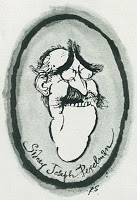 The program on which they appeared was clever enough, though not nearly as much so as it tried to be. It was, in fact, a too-obvious knockoff of
The program on which they appeared was clever enough, though not nearly as much so as it tried to be. It was, in fact, a too-obvious knockoff of 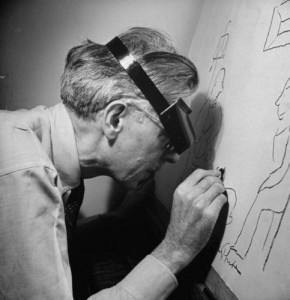 Even more interesting, though, is the precious opportunity that this crackly-sounding aircheck provides to hear the speaking voices of two distinguished American writers. Thurber sounds very much like the Ohio expatriate he was, plain-spoken and flat-voweled. Powell, by contrast, has a medium-high voice that is at once twittery and slightly hesitant—rather like a clever little girl who says cynical things so sweetly that it takes a moment or two for you to register them and be shocked.
Even more interesting, though, is the precious opportunity that this crackly-sounding aircheck provides to hear the speaking voices of two distinguished American writers. Thurber sounds very much like the Ohio expatriate he was, plain-spoken and flat-voweled. Powell, by contrast, has a medium-high voice that is at once twittery and slightly hesitant—rather like a clever little girl who says cynical things so sweetly that it takes a moment or two for you to register them and be shocked.
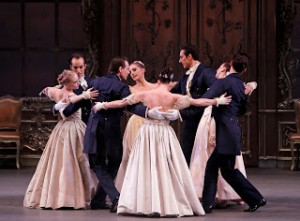 Both, I guess, since we didn’t go back in March, nor did we subsequently seek out dance of any kind (not counting Broadway, which is forever with us). But the seed was planted, and after I read Jacques d’Amboise’s
Both, I guess, since we didn’t go back in March, nor did we subsequently seek out dance of any kind (not counting Broadway, which is forever with us). But the seed was planted, and after I read Jacques d’Amboise’s 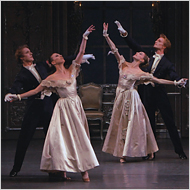 The performance that I saw fifteen years ago featured Kyra Nichols, the Balanchine dancer who meant the most to me in my balletgoing days. I
The performance that I saw fifteen years ago featured Kyra Nichols, the Balanchine dancer who meant the most to me in my balletgoing days. I 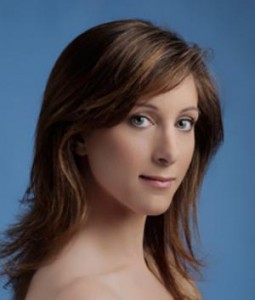 Then I walked past a poster announcing that we were about to see “Jennie Somogyi’s Farewell Performance.” Somogyi, who joined NYCB in 1994, is a member of the last generation of up-and-coming dancers whose careers I once
Then I walked past a poster announcing that we were about to see “Jennie Somogyi’s Farewell Performance.” Somogyi, who joined NYCB in 1994, is a member of the last generation of up-and-coming dancers whose careers I once 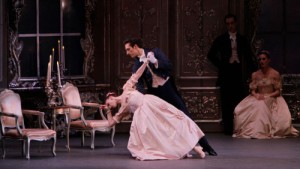 I won’t pretend to judge the merits of the performance of Liebeslieder Walzer that we saw yesterday afternoon. Not only is my critic’s eye out of practice, but it was also dimmed by tears. Instead I’ll cite two experts, one of whom, the late
I won’t pretend to judge the merits of the performance of Liebeslieder Walzer that we saw yesterday afternoon. Not only is my critic’s eye out of practice, but it was also dimmed by tears. Instead I’ll cite two experts, one of whom, the late  Part of what Haggin was getting at is that whatever else they were, Balanchine’s dances were theater above all. I can’t imagine that observation being more to the point, then or now, than in the case of Liebeslieder Walzer, which to my mind is one of the most extraordinary works of lyric theater created in the twentieth century, a masterpiece that is all the more miraculous because it is a plotless ballet whose poetic effect derives entirely from the fusion of music, movement, and décor. Richard Wagner couldn’t have conceived of a more radically unified work of art.
Part of what Haggin was getting at is that whatever else they were, Balanchine’s dances were theater above all. I can’t imagine that observation being more to the point, then or now, than in the case of Liebeslieder Walzer, which to my mind is one of the most extraordinary works of lyric theater created in the twentieth century, a masterpiece that is all the more miraculous because it is a plotless ballet whose poetic effect derives entirely from the fusion of music, movement, and décor. Richard Wagner couldn’t have conceived of a more radically unified work of art.